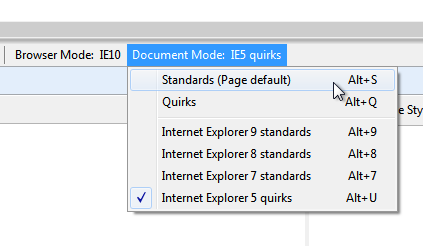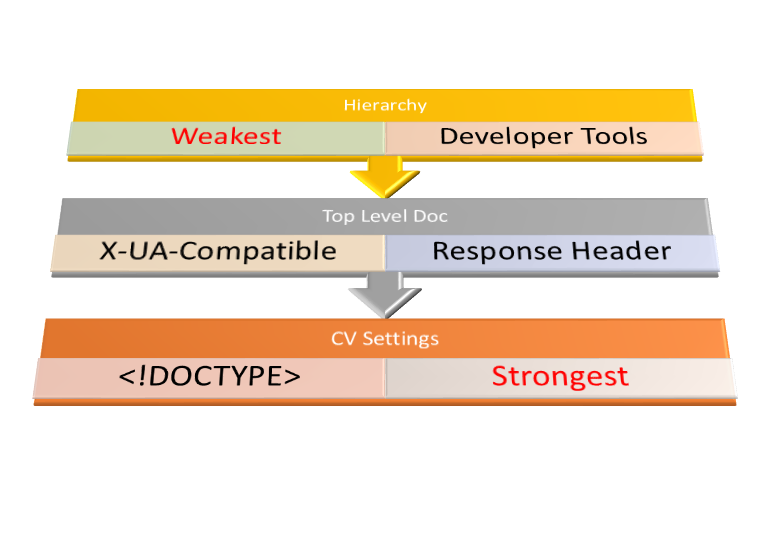
- SAP Community
- Products and Technology
- Technology
- Technology Blogs by SAP
- EP: Portal - Forcing Edge Mode (Browser Document M...
- Subscribe to RSS Feed
- Mark as New
- Mark as Read
- Bookmark
- Subscribe
- Printer Friendly Page
- Report Inappropriate Content
Introduction
In my experience across the Enterprise Portal area many of the scenarios that I deal with on a daily basis revolve around browser bases issues or scenarios that in some way, shape or form associate to the Web Browser Platform itself. From a high level perspective we think as a Web Browser Platform as a simple conduit through which we can gain access to and interact with Web Based Resources and this is indeed true. However we need to remember that with each Web Browser Platform comes a set of different parameter and property settings which need to be maintained in order to support optimal performance. In reference to "performance" here I do not mean the speed of the browser :lol: but rather the means in which it functions i.e. the rendering of the browser & subsequent display presented to end users.
Quirks, Standards, Edge..
I would like to stress the importance at looking over browser configurations and the various modes from the most simple standpoint possible. With browser related scenarios a simple issue can quickly become a complex scenario especially taking all the various parameters into account within a troubleshooting scenario.
In the interest of simplicity we can look at things as below (in a modern browser environment):
- Quirks: displays webpages as if users view them with older versions of the browsers.
- Standards: HTML 5 engine, new features are only supported in this mode.
Is there a way to "Force" all Pages to be displayed within Edge Mode?
If you want to achieve from a functional aspect "forcing" all Pages to run in browser document mode EDGE essentially here we are referring to standards.
To achieve this you would need to use the Standards Ajax Framework Page which is available from NW7.31 SP14 and 7.4 SP9. This is basically an Ajax framework page that runs in Standards Mode.
However this does not cover applications for example if you are using older HTMLB style applications these require Quirks Mode.
Attempting to run old applications that require Quirks mode, will need to be run in a new headerless window or new window in order to see the content.
Ajax Standards Mode Framework Page
Reviewing Different Modes
Remember we need to look at Internet Explorer as a Web Browser Platform with core fundamental underlying parameters which determine the way it functions and how it operates in association to an Enterprise Portal environment.
From a purely navigation approach here we are dealing with two key modes which are that of Browser & Document Mode.

What is the Browser Mode all about?
In short the browser mode is a user agent string sent to the server (which affects the User Agent only).
- When compatibility mode is selected the the User Agent is set to the oldest supported setting for the current browser.
- Tools > Compatibility View > F12 > Navigation > Navigation.UserAgent
- IE10, IE10 Compatibility View, IE9, IE8, IE7.

The User Agent is essentially a string (textual) which identifies the Browser & OS to for the Web Server. To provide insight with a working example if we take IE5 Quirks which is the oldest document mode as the baseline. This means Internet Explorer is telling the server its browser mode. According to the browsers mode the server then decides which resources CSS/JS should be sent back to the Browser.

So What is the Document Mode all about?
Document Mode: Determines how the browser (IE) renders the page.
- Essentially tells browsers how it wants it to be rendered.
- Browser decides which rendering engine should be used.
Remember
From a high level perspective let us remember that Document Mode determines how Internet Explorer is rendered.Quirks Mode displays the webpages as if they are within older IE versions while Standards Mode follows the HTML5 Engine with new features supported. The Quirks Mode syntax is different from the Standards Mode syntax.

- SAP Managed Tags:
- SAP Enterprise Portal,
- SAP NetWeaver,
- SAP NetWeaver Application Server
- Browser
- browser access
- browserdevtools
- browserdocumentmode
- browsermode
- browsers
- documentmode
- edge
- edgemode
- enterprise portal (ep)
- f12
- Fiori
- ie10
- ie11
- ie11insap
- ie11suppportpackages
- ie8
- ie9
- mobile portal
- Navigation
- netweaver
- nw73
- parameters
- portal
- portal on device
- portal-on-demand
- portal.
- portal7.3
- portal73
- portal74
- portalactivity
- portalactvity
- portalapp.xml
- portalhr
- portalthemesapui5nwbcabapbrandingtheming
- SAP Enterprise Portal 5.0
- SAP Enterprise Portal 6.0
- SAP NetWeaver
- SAP Netweaver 2004
- SAP Netweaver 7.0
- SAP Netweaver 7.2
- SAP Netweaver 7.3
- sap netweaver 7.4
- SAP NetWeaver Application Server
- sap netweaver platform
- sap portal
- settings
- webbrowserplatform
You must be a registered user to add a comment. If you've already registered, sign in. Otherwise, register and sign in.
-
ABAP CDS Views - CDC (Change Data Capture)
2 -
AI
1 -
Analyze Workload Data
1 -
BTP
1 -
Business and IT Integration
2 -
Business application stu
1 -
Business Technology Platform
1 -
Business Trends
1,661 -
Business Trends
88 -
CAP
1 -
cf
1 -
Cloud Foundry
1 -
Confluent
1 -
Customer COE Basics and Fundamentals
1 -
Customer COE Latest and Greatest
3 -
Customer Data Browser app
1 -
Data Analysis Tool
1 -
data migration
1 -
data transfer
1 -
Datasphere
2 -
Event Information
1,400 -
Event Information
65 -
Expert
1 -
Expert Insights
178 -
Expert Insights
280 -
General
1 -
Google cloud
1 -
Google Next'24
1 -
Kafka
1 -
Life at SAP
784 -
Life at SAP
11 -
Migrate your Data App
1 -
MTA
1 -
Network Performance Analysis
1 -
NodeJS
1 -
PDF
1 -
POC
1 -
Product Updates
4,577 -
Product Updates
330 -
Replication Flow
1 -
RisewithSAP
1 -
SAP BTP
1 -
SAP BTP Cloud Foundry
1 -
SAP Cloud ALM
1 -
SAP Cloud Application Programming Model
1 -
SAP Datasphere
2 -
SAP S4HANA Cloud
1 -
SAP S4HANA Migration Cockpit
1 -
Technology Updates
6,886 -
Technology Updates
408 -
Workload Fluctuations
1
- Single Sign On to SAP Cloud Integration (CPI runtime) from an external Identity Provider in Technology Blogs by SAP
- Downloading multiple files as a single zip folder in SAP UI5 Application in Technology Blogs by Members
- DMS(Database Management System) in HANA While trying to upload Document using BAPI. File is not open in Technology Q&A
- ODATA call to views in a HANADB from a Portal accessible to authorized users in Technology Q&A
- Consuming OData URL in CPI with GET Method in Technology Blogs by Members
| User | Count |
|---|---|
| 13 | |
| 11 | |
| 10 | |
| 9 | |
| 9 | |
| 7 | |
| 6 | |
| 5 | |
| 5 | |
| 5 |